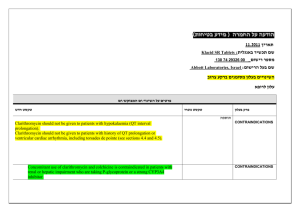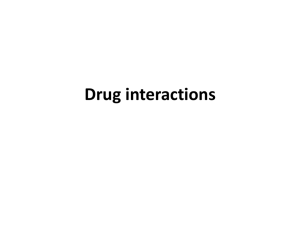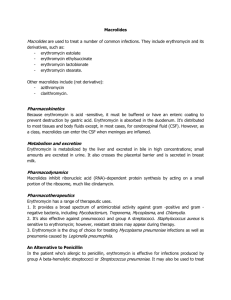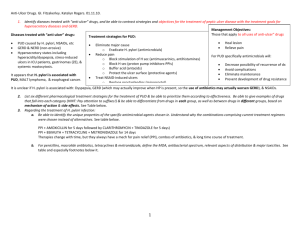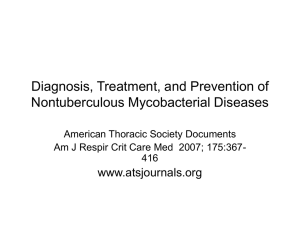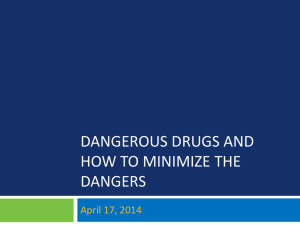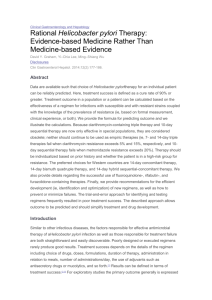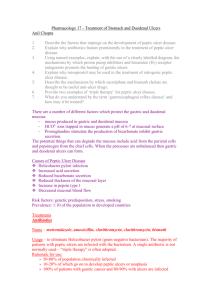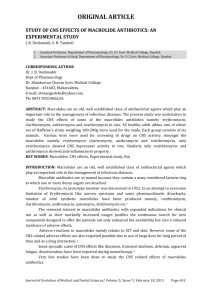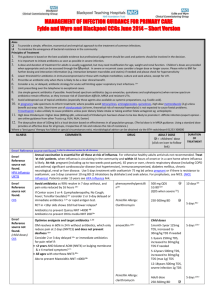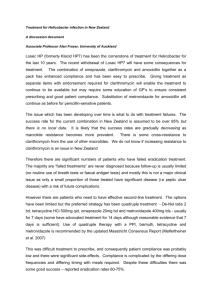Clarithromycin is known to inhibit Pgp. When clarithromycin and
advertisement
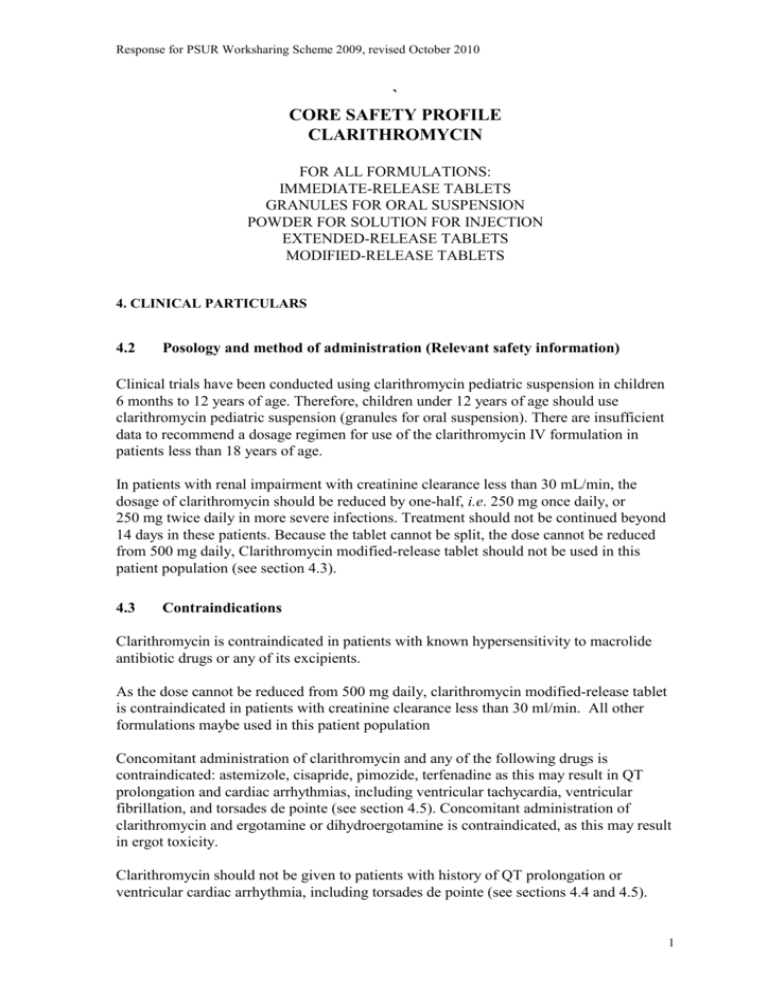
Response for PSUR Worksharing Scheme 2009, revised October 2010 ` CORE SAFETY PROFILE CLARITHROMYCIN FOR ALL FORMULATIONS: IMMEDIATE-RELEASE TABLETS GRANULES FOR ORAL SUSPENSION POWDER FOR SOLUTION FOR INJECTION EXTENDED-RELEASE TABLETS MODIFIED-RELEASE TABLETS 4. CLINICAL PARTICULARS 4.2 Posology and method of administration (Relevant safety information) Clinical trials have been conducted using clarithromycin pediatric suspension in children 6 months to 12 years of age. Therefore, children under 12 years of age should use clarithromycin pediatric suspension (granules for oral suspension). There are insufficient data to recommend a dosage regimen for use of the clarithromycin IV formulation in patients less than 18 years of age. In patients with renal impairment with creatinine clearance less than 30 mL/min, the dosage of clarithromycin should be reduced by one-half, i.e. 250 mg once daily, or 250 mg twice daily in more severe infections. Treatment should not be continued beyond 14 days in these patients. Because the tablet cannot be split, the dose cannot be reduced from 500 mg daily, Clarithromycin modified-release tablet should not be used in this patient population (see section 4.3). 4.3 Contraindications Clarithromycin is contraindicated in patients with known hypersensitivity to macrolide antibiotic drugs or any of its excipients. As the dose cannot be reduced from 500 mg daily, clarithromycin modified-release tablet is contraindicated in patients with creatinine clearance less than 30 ml/min. All other formulations maybe used in this patient population Concomitant administration of clarithromycin and any of the following drugs is contraindicated: astemizole, cisapride, pimozide, terfenadine as this may result in QT prolongation and cardiac arrhythmias, including ventricular tachycardia, ventricular fibrillation, and torsades de pointe (see section 4.5). Concomitant administration of clarithromycin and ergotamine or dihydroergotamine is contraindicated, as this may result in ergot toxicity. Clarithromycin should not be given to patients with history of QT prolongation or ventricular cardiac arrhythmia, including torsades de pointe (see sections 4.4 and 4.5). 1 Response for PSUR Worksharing Scheme 2009, revised October 2010 Clarithromycin should not be used concomitantly with HMG-CoA reductase inhibitors (statins), lovastatin or simvastatin, due to the risk of rhabdomyolysis. Treatment with these agents should be discontinued during clarithromycin treatment (see section 4.4). Clarithromycin should not be given to patients with hypokalaemia (risk of prolongation of QT-time) Clarithromycin should not be used in patients who suffer from severe hepatic failure in combination with renal impairment. 4.4 Special warnings and special precautions for use The physician should not prescribe clarithromycin to pregnant women without carefully weighing the benefits against risk, particularly during the first three months of pregnancy (see section 4.6). Caution is advised in patients with severe renal insufficiency (see section 4.2). Clarithromycin is principally excreted by the liver. Therefore, caution should be exercised in administering the antibiotic to patients with impaired hepatic function. Caution should also be exercised when administering clarithromycin to patients with moderate to severe renal impairment. Cases of fatal hepatic failure (see section 4.8) have been reported. Some patients may have had pre-existing hepatic disease or may have been taking other hepatotoxic medicinal products. Patients should be advised to stop treatment and contact their doctor if signs and symptoms of hepatic disease develop, such as anorexia, jaundice, dark urine, pruritus, or tender abdomen. Pseudomembranous colitis has been reported with nearly all antibacterial agents, including macrolides, and may range in severity from mild to life-threatening. Clostridium difficileassociated diarrhea (CDAD) has been reported with use of nearly all antibacterial agents including clarithromycin, and may range in severity from mild diarrhea to fatal colitis. Treatment with antibacterial agents alters the normal flora of the colon, which may lead to overgrowth of C. difficile. CDAD must be considered in all patients who present with diarrhea following antibiotic use. Careful medical history is necessary since CDAD has been reported to occur over two months after the administration of antibacterial agents. Therefore, discontinuation of clarithromycin therapy should be considered regardless of the indication. Microbial testing should be performed and adequate treatment initiated. Drugs inhibiting peristalsis should be avoided. Exacerbation of symptoms of myasthenia gravis has been reported in patients receiving clarithromycin therapy. There have been post-marketing reports of colchicine toxicity with concomitant use of clarithromycin and colchicine, especially in the elderly, some of which occurred in patients with renal insufficiency. Deaths have been reported in some such patients (see section 4.5). If concomitant administration of colchicine and clarithromycin is necessary, patients should be monitored for clinical symptoms of colchicine toxicity. Caution is advised regarding concomitant administration of clarithromycin and triazolobenzodiazepines, such as triazolam, and midazolam (see section 4.5). 2 Response for PSUR Worksharing Scheme 2009, revised October 2010 Caution is advised regarding concomitant administration of clarithromycin with other ototoxic drugs, especially with aminoglycosides. Monitoring of vestibular and auditory function should be carried out during and after treatment Due to the risk for QT prolongation, clarithromycin should be used with caution in patients with coronary artery disease, severe cardiac insufficiency, hypomagnesemia, bradycardia (<50 bpm), or when co-administered with other medicinal products associated with QT prolongation (see section 4.5). Clarithromycin must not be used in patients with congenital or documented acquired QT prolongation or history of ventricular arrhythmia (see section 4.3). Pneumonia: In view of the emerging resistance of Streptococcus pneumoniae to macrolides, it is important that sensitivity testing be performed when prescribing clarithromycin for communityacquired pneumonia. In hospital-acquired pneumonia, clarithromycin should be used in combination with additional appropriate antibiotics. Skin and soft tissue infections of mild to moderate severity: These infections are most often caused by Staphylococcus aureus and Streptococcus pyogenes, both of which may be resistant to macrolides. Therefore, it is important that sensitivity testing be performed. In cases where beta– lactam antibiotics cannot be used (e.g. allergy), other antibiotics, such as clindamycin, may be the drug of first choice. Currently, macrolides are only considered to play a role in some skin and soft tissue infections, such as those caused by Corynebacterium minutissimum (erythrasma), acne vulgaris, and erysipelas and in situations where penicillin treatment cannot be used. In the event of severe acute hypersensitivity reactions, such as anaphylaxis, Stevens-Johnson Syndrome, and toxic epidermal necrolysis, clarithromycin therapy should be discontinued immediately and appropriate treatment should be urgently initiated. Clarithromycin should be used with caution when administered concurrently with medications that induce the cytochrome CYP3A4 enzyme (see section 4.5). HMG-CoA reductase inhibitors: Concomitant use of clarithromycin with lovastatin or simvastatin is contraindicated (see section 4.3). As with other macrolides, clarithromycin has been reported to increase concentrations of HMG-CoA reductase inhibitors (see section 4.5). Rare reports of rhabdomyolysis have been reported in patients taking these drugs concomitantly. Patients should be monitored for signs and symptoms of myopathy. Rare reports of rhabdomyolysis have also been reported in patients taking atorvastatin or rosuvastatin concomitantly with clarithromycin. When used with clarithromycin, atorvastatin or rosuvastatin should be administered in the lowest possible doses. Adjustment of the statin dose or use of a statin that is not dependent on CYP3A metabolism (e.g. fluvastatin or pravastatin) should be considered. Oral hypoglycemic agents/Insulin: The concomitant use of clarithromycin and oral hypoglycemic agents and/or insulin can result in significant hypoglycemia. With certain hypoglycemic drugs such as nateglinide, pioglitazone, repaglinide and rosiglitazone, inhibition of CYP3A enzyme by clarithromycin may be involved and could cause hypolgycemia when used concomitantly. Careful monitoring of glucose is recommended. Oral anticoagulants: There is a risk of serious hemorrhage and significant elevations in International Normalized Ratio (INR) and prothrombin time when clarithromycin is coadministered with warfarin (see section 4.5). INR and prothrombin times should be frequently monitored while patients are receiving clarithromycin and oral anticoagulants concurrently. 3 Response for PSUR Worksharing Scheme 2009, revised October 2010 Use of any antimicrobial therapy, such as clarithromycin, to treat H. pylori infection may select for drug-resistant organisms. Long-term use may, as with other antibiotics, result in colonization with increased numbers of non-susceptible bacteria and fungi. If superinfections occur, appropriate therapy should be instituted. Attention should also be paid to the possibility of cross resistance between clarithromycin and other macrolide drugs, as well as lincomycin and clindamycin. 4.5 Interaction with other medicaments and other forms of interaction The use of the following drugs is strictly contraindicated due to the potential for severe drug interaction effects: Cisapride, pimozide, astemizole and terfenadine Elevated cisapride levels have been reported in patients receiving clarithromycin and cisapride concomitantly. This may result in QT prolongation and cardiac arrhythmias including ventricular tachycardia, ventricular fibrillation and torsades de pointes. Similar effects have been observed in patients taking clarithromycin and pimozide concomitantly (see section 4.3). Macrolides have been reported to alter the metabolism of terfenadine resulting in increased levels of terfenadine which has occasionally been associated with cardiac arrhythmias such as QT prolongation, ventricular tachycardia, ventricular fibrillation and torsades de pointes (see section 4.3). In one study in 14 healthy volunteers, the concomitant administration of clarithromycin and terfenadine resulted in a two to three fold increase in the serum level of the acid metabolite of terfenadine and in prolongation of the QT interval which did not lead to any clinically detectable effect. Similar effects have been observed with concomitant administration of astemizole and other macrolides. Ergotamine/dihydroergotamine Postmarketing reports indicate that co-administration of clarithromycin with ergotamine or dihydroergotamine has been associated with acute ergot toxicity characterized by vasospasm, and ischemia of the extremities and other tissues including the central nervous system. Concomitant administration of clarithromycin and these medicinal products is contraindicated (see section 4.3). Effects of other medicinal products on clarithromycin Drugs that are inducers of CYP3A (e.g. rifampicin, phenytoin, carbamazepine, phenobarbital, St John’s wort) may induce the metabolism of clarithromycin. This may result in sub-therapeutic levels of clarithromycin leading to reduced efficacy. Furthermore, it might be necessary to monitor the plasma levels of the CYP3A inducer, which could be increased owing to the inhibition of CYP3A by clarithromycin (see also the relevant product information for the CYP3A4 inhibitor administered). Concomitant administration of rifabutin and clarithromycin resulted in an increase in rifabutin, and decrease in clarithromycin serum levels together with an increased risk of uveitis. 4 Response for PSUR Worksharing Scheme 2009, revised October 2010 The following drugs are known or suspected to affect circulating concentrations of clarithromycin; clarithromycin dosage adjustment or consideration of alternative treatments may be required. Efavirenz, nevirapine, rifampicin, rifabutin and rifapentine Strong inducers of the cytochrome P450 metabolism system such as efavirenz, nevirapine, rifampicin, rifabutin, and rifapentine may accelerate the metabolism of clarithromycin and thus lower the plasma levels of clarithromycin, while increasing those of 14-OHclarithromycin, a metabolite that is also microbiologically active. Since the microbiological activities of clarithromycin and 14-OH-clarithromycin are different for different bacteria, the intended therapeutic effect could be impaired during concomitant administration of clarithromycin and enzyme inducers. Fluconazole Concomitant administration of fluconazole 200 mg daily and clarithromycin 500 mg twice daily to 21 healthy volunteers led to increases in the mean steady-state minimum clarithromycin concentration (Cmin) and area under the curve (AUC) of 33% and 18% respectively. Steady state concentrations of the active metabolite 14-OH-clarithromycin were not significantly affected by concomitant administration of fluconazole. No clarithromycin dose adjustment is necessary. Ritonavir A pharmacokinetic study demonstrated that the concomitant administration of ritonavir 200 mg every eight hours and clarithromycin 500 mg every 12 hours resulted in a marked inhibition of the metabolism of clarithromycin. The clarithromycin Cmax increased by 31%, Cmin increased 182% and AUC increased by 77% with concomitant administration of ritonavir. An essentially complete inhibition of the formation of 14-OH-clarithromycin was noted. Because of the large therapeutic window for clarithromycin, no dosage reduction should be necessary in patients with normal renal function. However, for patients with renal impairment, the following dosage adjustments should be considered: For patients with CLCR 30 to 60 mL/min the dose of clarithromycin should be reduced by 50%. For patients with CLCR <30 mL/min the dose of clarithromycin should be decreased by 75%. Doses of clarithromycin greater than 1 gm/day should not be coadministered with ritonavir. Similar dose adjustments should be considered in patients with reduced renal function when ritonavir is used as a pharmacokinetic enhancer with other HIV protease inhibitors including atazanavir and saquinavir (see section below, Bi-directional drug interactions) Effect of clarithromycin on other medicinal products CYP3A-based interactions Co-administration of clarithromycin, known to inhibit CYP3A, and a drug primarily metabolized by CYP3A may be associated with elevations in drug concentrations that could increase or prolong both therapeutic and adverse effects of the concomitant drug. Clarithromycin should be used with caution in patients receiving treatment with other drugs known to be CYP3A enzyme substrates, especially if the CYP3A substrate has a narrow safety margin (e.g. carbamazepine) and/or the substrate is extensively metabolized by this enzyme. 5 Response for PSUR Worksharing Scheme 2009, revised October 2010 Dosage adjustments may be considered, and when possible, serum concentrations of drugs primarily metabolized by CYP3A should be monitored closely in patients concurrently receiving clarithromycin. The following drugs or drug classes are known or suspected to be metabolized by the same CYP3A isozyme: alprazolam, astemizole, carbamazepine, cilostazol, cisapride, cyclosporine, disopyramide, ergot alkaloids, lovastatin, methylprednisolone, midazolam, omeprazole, oral anticoagulants (e.g. warfarin), pimozide, quinidine, rifabutin, sildenafil, simvastatin, sirolimus, tacrolimus, terfenadine, triazolam and vinblastine. Drugs interacting by similar mechanisms through other isozymes within the cytochrome P450 system include phenytoin, theophylline and valproate. Antiarrhythmics There have been postmarketing reports of torsades de pointes occurring with concurrent use of clarithromycin and quinidine or disopyramide. Electrocardiograms should be monitored for QT prolongation during co-administration of clarithromycin with these drugs. Serum levels of quinidine and disopyramide should be monitored during clarithromycin therapy. Omeprazole Clarithromycin (500 mg every 8 hours) was given in combination with omeprazole (40 mg daily) to healthy adult subjects. The steady-state plasma concentrations of omeprazole were increased (Cmax, AUC0-24, and t1/2 increased by 30%, 89%, and 34%, respectively), by the concomitant administration of clarithromycin. The mean 24-hour gastric pH value was 5.2 when omeprazole was administered alone and 5.7 when omeprazole was co-administered with clarithromycin. Sildenafil, tadalafil, and vardenafil Each of these phosphodiesterase inhibitors is metabolized, at least in part, by CYP3A, and CYP3A may be inhibited by concomitantly administered clarithromycin. Coadministration of clarithromycin with sildenafil, tadalafil or vardenafil would likely result in increased phosphodiesterase inhibitor exposure. Reduction of sildenafil, tadalafil and vardenafil dosages should be considered when these drugs are co-administered with clarithromycin. Theophylline, carbamazepine Results of clinical studies indicate there was a modest but statistically significant (p0.05) increase of circulating theophylline or carbamazepine levels when either of these drugs were administered concomitantly with clarithromycin. Dose reduction may need to be considered. Tolterodine The primary route of metabolism for tolterodine is via the 2D6 isoform of cytochrome P450 (CYP2D6). However, in a subset of the population devoid of CYP2D6, the identified pathway of metabolism is via CYP3A. In this population subset, inhibition of CYP3A results in significantly higher serum concentrations of tolterodine. A reduction in 6 Response for PSUR Worksharing Scheme 2009, revised October 2010 tolterodine dosage may be necessary in the presence of CYP3A inhibitors, such as clarithromycin in the CYP2D6 poor metabolizer population. Triazolobenzodiazepines (e.g. alprazolam, midazolam, triazolam) When midazolam was co-administered with clarithromycin tablets (500 mg twice daily), midazolam AUC was increased 2.7-fold after intravenous administration of midazolam and 7-fold after oral administration. Concomitant administration of oral midazolam and clarithromycin should be avoided. If intravenous midazolam is co-administered with clarithromycin, the patient must be closely monitored to allow dose adjustment. The same precautions should also apply to other benzodiazepines that are metabolized by CYP3A, including triazolam and alprazolam. For benzodiazepines which are not dependent on CYP3A for their elimination (temazepam, nitrazepam, lorazepam), a clinically important interaction with clarithromycin is unlikely. There have been post-marketing reports of drug interactions and central nervous system (CNS) effects (e.g. somnolence and confusion) with the concomitant use of clarithromycin and triazolam. Monitoring the patient for increased CNS pharmacological effects is suggested. Other drug interactions Colchicine Colchicine is a substrate for both CYP3A and the efflux transporter, P-glycoprotein (Pgp). Clarithromycin and other macrolides are known to inhibit CYP3A and Pgp. When clarithromycin and colchicine are administered together, inhibition of Pgp and/or CYP3A by clarithromycin may lead to increased exposure to colchicine. Patients should be monitored for clinical symptoms of colchicine toxicity (see section 4.4). Digoxin Digoxin is thought to be a substrate for the efflux transporter, P-glycoprotein (Pgp). Clarithromycin is known to inhibit Pgp. When clarithromycin and digoxin are administered together, inhibition of Pgp by clarithromycin may lead to increased exposure to digoxin. Elevated digoxin serum concentrations in patients receiving clarithromycin and digoxin concomitantly have also been reported in post marketing surveillance. Some patients have shown clinical signs consistent with digoxin toxicity, including potentially fatal arrhythmias. Serum digoxin concentrations should be carefully monitored while patients are receiving digoxin and clarithromycin simultaneously. Zidovudine Simultaneous oral administration of clarithromycin tablets and zidovudine to HIVinfected adult patients may result in decreased steady-state zidovudine concentrations. Because clarithromycin appears to interfere with the absorption of simultaneously administered oral zidovudine, this interaction can be largely avoided by staggering the doses of clarithromycin and zidovudine to allow for a 4-hour interval between each medication. This interaction does not appear to occur in paediatric HIV-infected patients taking clarithromycin suspension with zidovudine or dideoxyinosine. This interaction is unlikely when clarithromycin is administered via intravenous infusion. Phenytoin and Valproate 7 Response for PSUR Worksharing Scheme 2009, revised October 2010 There have been spontaneous or published reports of interactions of CYP3A inhibitors, including clarithromycin with drugs not thought to be metabolized by CYP3A (e.g. phenytoin and valproate). Serum level determinations are recommended for these drugs when administered concomitantly with clarithromycin. Increased serum levels have been reported Bi-directional drug interactions Atazanavir Both clarithromycin and atazanavir are substrates and inhibitors of CYP3A, and there is evidence of a bi-directional drug interaction. Co-administration of clarithromycin (500 mg twice daily) with atazanavir (400 mg once daily) resulted in a 2-fold increase in exposure to clarithromycin and a 70% decrease in exposure to 14-OH-clarithromycin, with a 28% increase in the AUC of atazanavir. Because of the large therapeutic window for clarithromycin, no dosage reduction should be necessary in patients with normal renal function. For patients with moderate renal function (creatinine clearance 30 to 60 mL/min), the dose of clarithromycin should be decreased by 50%. For patients with creatinine clearance <30 mL/min, the dose of clarithromycin should be decreased by 75% using an appropriate clarithromycin formulation. Doses of clarithromycin greater than 1000 mg per day should not be co-administered with protease inhibitors. Itraconazole Both clarithromycin and itraconazole are substrates and inhibitors of CYP3A, leading to a bidirectional drug interaction. Clarithromycin may increase the plasma levels of itraconazole, while itraconazole may increase the plasma levels of clarithromycin. Patients taking itraconazole and clarithromycin concomitantly should be monitored closely for signs or symptoms of increased or prolonged pharmacologic effect. Saquinavir Both clarithromycin and saquinavir are substrates and inhibitors of CYP3A, and there is evidence of a bi-directional drug interaction. Concomitant administration of clarithromycin (500 mg twice daily) and saquinavir (soft gelatin capsules, 1200 mg three times daily) to 12 healthy volunteers resulted in steady-state AUC and Cmax values of saquinavir which were 177% and 187% higher than those seen with saquinavir alone. Clarithromycin AUC and Cmax values were approximately 40% higher than those seen with clarithromycin alone. No dose adjustment is required when the two drugs are coadministered for a limited time at the doses/formulations studied. Observations from drug interaction studies using the soft gelatin capsule formulation may not be representative of the effects seen using the saquinavir hard gelatin capsule. Observations from drug interaction studies performed with saquinavir alone may not be representative of the effects seen with saquinavir/ritonavir therapy. When saquinavir is co-administered with ritonavir, consideration should be given to the potential effects of ritonavir on clarithromycin. Verapamil Hypotension, bradyarrhythmias and lactic acidosis have been observed in patients taking clarithromycin and verapamil concomitantly. 4.6 Pregnancy and lactation 8 Response for PSUR Worksharing Scheme 2009, revised October 2010 The safety of clarithromycin for use during pregnancy and breast feeding of infants has not been established. Based on variable results obtained from studies in mice, rats, rabbits and monkeys, the possibility of adverse effects on embryofoetal development cannot be excluded. Therefore, use during pregnancy is not advised without carefully weighing the benefits against risk. Clarithromycin is excreted into human breast milk. 4.7 Effects on ability to drive and use machines There are no data on the effect of clarithromycin on the ability to drive or use machines. The potential for dizziness, vertigo, confusion and disorientation, which may occur with the medication, should be taken into account before patients drive or use machines. 4.8 Undesirable Effects a. Summary of the safety profile The most frequent and common adverse reactions related to clarithromycin therapy for both adult and pediatric populations are abdominal pain, diarrhea, nausea, vomiting and taste perversion. These adverse reactions are usually mild in intensity and are consistent with the known safety profile of macrolide antibiotics. (see section b of section 4.8) There was no significant difference in the incidence of these gastrointestinal adverse reactions during clinical trials between the patient population with or without preexisting mycobacterial infections. b. Tabulated summary of adverse reactions The following table displays adverse reactions reported in clinical trials and from postmarketing experience with clarithromycin immediate-release tablets, granules for oral suspension, powder for solution for injection, extended-release tablets and modifiedrelease tablets. The reactions considered at least possibly related to clarithromycin are displayed by system organ class and frequency using the following convention: very common (≥1/10), common (≥ 1/100 to < 1/10), uncommon (≥1/1,000 to < 1/100) and not known (adverse reactions from post-marketing experience; cannot be estimated from the available data). Within each frequency grouping, adverse reactions are presented in order of decreasing seriousness when the seriousness could be assessed. System Organ Class Infections and infestations Very common Common Uncommon (≥1/10 ≥ 1/100 to < 1/10 ≥1/1,000 to < 1/100 Cellulitis1, candidiasis, gastroenteritis2,infection3, vaginal infection Not Known (cannot be estimated from the available data) Pseudomembranous colitis, erysipelas, erythrasma 9 Response for PSUR Worksharing Scheme 2009, revised October 2010 System Organ Class Blood and lymphatic system Immune system disorders5 Metabolism and nutrition disorders Psychiatric disorders Nervous system disorders Very common Common Insomnia Dysgeusia, headache, taste perversion Ear and labyrinth disorders Cardiac disorders Vascular disorders Respiratory, thoracic and mediastinal disorder Gastrointestinal disorders Vasodilation1 Hepatobiliary disorders Liver function test abnormal Skin and subcutaneous tissue disorders Rash, hyperhidrosis Musculoskeletal and connective tissue disorders Uncommon Not Known Leukopenia, neutropenia4, thrombocythemia3, eosinophilia4 Anaphylactoid reaction1, hypersensitivity Anorexia, decreased appetite Anxiety, nervousness3, screaming3 Agranulocytosis, thrombocytopenia Loss of consciousness1, dyskinesia1, dizziness, somnolence7, tremor Vertigo, hearing impaired, tinnitus Cardiac arrest1, atrial fibrillation1, electrocardiogram QT prolonged8, extrasystoles1, palpitations Anaphylactic reaction Hypoglycaemia6 Psychotic disorder, confusional state, depersonalisation, depression, disorientation, hallucination, abnormal dreams Convulsion, ageusia, parosmia, anosmia Deafness Torsade de pointes8, ventricular tachycardia8 Hemorrhage9 1 2 Asthma , epistaxis , pulmonary embolism1 Diarrhea10, vomiting, dyspepsia, nausea, abdominal pain Esophagitis1, gastrooesophageal reflux disease2, gastritis, proctalgia2, stomatitis, glossitis, abdominal distension4, constipation, dry mouth, eructation, flatulence, Cholestasis4, hepatitis4, alanine aminotransferase increased, aspartate aminotransferase increased, gammaglutamyltransferase increased4 Dermatitis bullous1, pruritus, urticaria, rash maculo-papular3 Muscle spasms3, musculoskeletal stiffness1, myalgia2 Pancreatitis acute, tongue discolouration, tooth discoloration Hepatic failure11, jaundice hepatocellular Stevens-Johnson syndrome5, toxic epidermal necrolysis5, drug rash with eosinophilia and systemic symptoms (DRESS), acne Rhabdomyolysis2,12, myopathy 10 Response for PSUR Worksharing Scheme 2009, revised October 2010 System Organ Class Renal and urinary disorders Very common General disorders and administration site conditions Investigations Injection site phlebitis1 Common Injection site pain1, injection site inflammation1 Uncommon Not Known Blood creatinine increased1, blood urea increased1 Malaise4, pyrexia3, asthenia, chest pain4, chills4, fatigue4 Albumin globulin ratio abnormal1, blood alkaline phosphatase increased4, blood lactate dehydrogenase increased4 Renal failure, nephritis interstitial International normalised ratio increased9, prothrombin time prolonged9, urine color abnormal 1 ADRs reported only for the Powder for Solution for Injection formulation ADRs reported only for the Extended-Release Tablets formulation 3 ADRs reported only for the Granules for Oral Suspension formulation 4 ADRs reported only for the Immediate-Release Tablets formulation 5,8,10,11,12 See section a) 6,7,9 See section c) 2 c. Description of selected adverse reactions Injection site phlebitis, injection site pain, vessel puncture site pain, and injection site inflammation are specific to the clarithromycin intravenous formulation. In very rare instances, hepatic failure with fatal outcome has been reported and generally has been associated with serious underlying diseases and/or concomitant medications (see section 4.4). A special attention to diarrhea should be paid as Clostridium difficile-associated diarrhea (CDAD) has been reported with use of nearly all antibacterial agents including clarithromycin, and may range in severity from mild diarrhea to fatal colitis. (see section 4.4) In the event of severe acute hypersensitivity reactions, such as anaphylaxis, StevensJohnson Syndrome and toxic epidermal necrolysis, clarithromycin therapy should be discontinued immediately and appropriate treatment should be urgently initiated (see section 4.4). As with other macrolides, QT prolongation, ventricular tachycardia, and torsade de pointes have rarely been reported with clarithromycin (see section 4.4 and 4.5). Pseudomembranous colitis has been reported with nearly all antibacterial agents, including clarithromycin, and may range in severity from mild to life threatening. Therefore, it is important to consider this diagnosis in patients who present with diarrhea subsequent to the administration of antibacterial agents (see section 4.4). In some of the reports of rhabdomyolysis, clarithromycin was administered concomitantly with statins, fibrates, colchicine or allopurinol (see section 4.3 and 4.4). 11 Response for PSUR Worksharing Scheme 2009, revised October 2010 There have been post-marketing reports of colchicine toxicity with concomitant use of clarithromycin and colchicine, especially in elderly and/or patients with renal insufficiency, some with a fatal outcome. (see sections 4.4 and 4.5). There have been rare reports of hypoglycemia, some of which have occurred in patients on concomitant oral hypoglycemic agents or insulin (see section 4.4 and 4.5). There have been post-marketing reports of drug interactions and central nervous system (CNS) effects (e.g. somnolence and confusion) with the concomitant use of clarithromycin and triazolam. Monitoring the patient for increased CNS pharmacological effects is suggested (see section 4.5). There is a risk of serious hemorrhage and significant elevations in INR and prothrombin time when clarithromycin is co-administered with warfarin. INR and prothrombin times should be frequently monitored while patients are receiving clarithromycin and oral anticoagulants concurrently (see section 4.4 and 4.5). There have been rare reports of clarithromycin ER tablets in the stool, many of which have occurred in patients with anatomic (including ileostomy or colostomy) or functional gastrointestinal disorders with shortened GI transit times. In several reports, tablet residues have occurred in the context of diarrhea. It is recommended that patients who experience tablet residue in the stool and no improvement in their condition should be switched to a different clarithromycin formulation (e.g. suspension) or another antibiotic. Special population: Adverse Reactions in Immunocompromised Patients (see section e) d. Paediatric populations Clinical trials have been conducted using clarithromycin paediatric suspension in children 6 months to 12 years of age. Therefore, children under 12 years of age should use clarithromycin paediatric suspension. There are insufficient data to recommend a dosage regimen for use of the clarithromycin IV formulation in patients less than 18 years of age. Frequency, type and severity of adverse reactions in children are expected to be the same as in adults. e. Other special populations Immunocompromised patients In AIDS and other immunocompromised patients treated with the higher doses of clarithromycin over long periods of time for mycobacterial infections, it was often difficult to distinguish adverse events possibly associated with clarithromycin administration from underlying signs of Human Immunodeficiency Virus (HIV) disease or intercurrent illness. In adult patients, the most frequently reported adverse reactions by patients treated with total daily doses of 1000 mg and 2000mg of clarithromycin were: nausea, vomiting, taste 12 Response for PSUR Worksharing Scheme 2009, revised October 2010 perversion, abdominal pain, diarrhea, rash, flatulence, headache, constipation, hearing disturbance, Serum Glutamic Oxaloacetic Transaminase (SGOT) and Serum Glutamic Pyruvate Transaminase (SGPT) elevations. Additional low-frequency events included dyspnoea, insomnia and dry mouth. The incidences were comparable for patients treated with 1000mg and 2000mg, but were generally about 3 to 4 times as frequent for those patients who received total daily doses of 4000mg of clarithromycin. In these immunocompromised patients, evaluations of laboratory values were made by analysing those values outside the seriously abnormal level (i.e. the extreme high or low limit) for the specified test. On the basis of these criteria, about 2% to 3% of those patients who received 1000mg or 2000mg of clarithromycin daily had seriously abnormal elevated levels of SGOT and SGPT, and abnormally low white blood cell and platelet counts. A lower percentage of patients in these two dosage groups also had elevated Blood Urea Nitrogen levels. Slightly higher incidences of abnormal values were noted for patients who received 4000mg daily for all parameters except White Blood Cell. 4.9 Overdosage Reports indicate the ingestion of large amounts of clarithromycin can be expected to produce gastrointestinal symptoms. One patient who had a history of bipolar disorder ingested eight grams of clarithromycin and showed altered mental status, paranoid behavior, hypokalemia, and hypoxemia. Adverse reactions accompanying overdosage should be treated by the prompt elimination of unabsorbed drug and supportive measures. As with other macrolides, clarithromycin serum levels are not expected to be appreciably affected by hemodialysis or peritoneal dialysis. In the case of overdosage, clarithromycin IV (powder for solution for injection) should be discontinued and all other appropriate supportive measures should be instituted. 13
